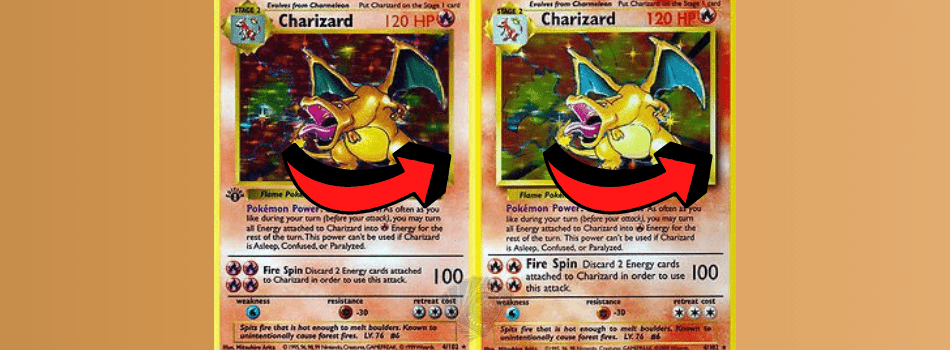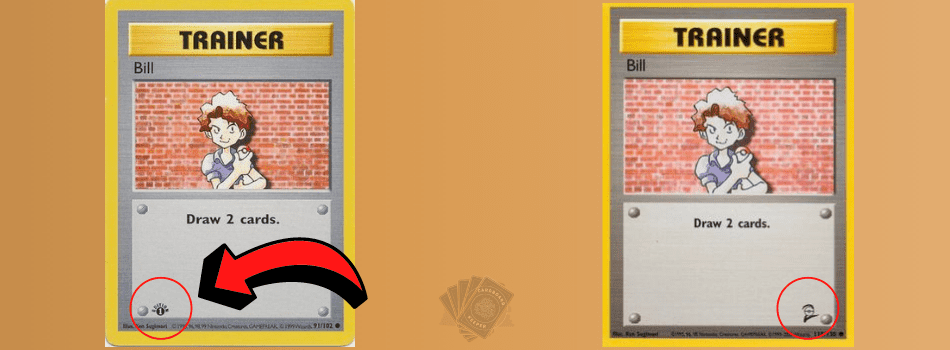Collecting Pokémon cards is becoming an increasingly popular hobby, but as it does, it becomes increasingly more expensive. When you’re offered a trade, you might be tempted to accept the offer without a second thought, but if you know how to identify rare cards, you will be able to better identify the value of your (and others’) cards.
Three main elements can help one identify a 1st Edition Base Set Pokémon card: the unique 1st Edition stamp, the lack of a shadow on the right of the frame, and copyright dates 1995, ’96, ’98, and ’99. Other Base Set editions include Shadowless and Unlimited, which are also very valuable.
In this article, we’ll discuss the different ways to identify 1st edition Pokémon cards, the rarest kinds of Pokémon cards around, and the highest value Pokémon cards.
3 Ways To Identify Base Set Pokemon Cards (Pokemon Card Worth)
There are three main design components on your Pokémon cards that will give away whether or not your card is one of the 1st edition cards from Pokemon’s base set.
Luckily for us, it isn’t too hard to spot when you know what you are looking for. These three identifiers are
- The shadow on the right of the frame
- The appropriate copyright dates
- The unique 1st Edition stamp.
The base set of Pokémon cards had three different runs:
- 1st Edition
- Shadowless
- Unlimited
These different runs each have a different combination of these components, and this helps collectors to differentiate between the separate runs, which can cause a card to have drastically different values.
Even with these indicators, though, the cards don’t look too different from each other, which helps to lend a certain air of uniformity to the game. However, this can make it easy to misidentify for even veteran collectors which version of a Pokemon card they have if they’re not paying attention.
I survived over 156 random Pokémon card collectors from all over the world and asked them if they knew what the 3 identifying factors were of a First Edition base set Pokémon card was.
What I found was that the information was less commonplace than I thought among Pokemon card collectors.
- None – 25.0% of Pokemon collectors couldn’t idenitfy any of the factors assicted with First Edition base set Pokémon cards.
- 1 Factor – 24.4% of Pokemon collectors said they could identiy at least 1 Factors.
- 2 Factors – 15.4% of Pokemon collectors said they could identiy at least 2 Factors.
- All Factors – 35.3% of Pokemon collectors said they could identiy all 3 Factors.
Another way to interpret this data is that 64.7% of the people who survived would potentially fail to notice that they have a First Edition Base Set Pokémon card sitting in their collection!
Identifing 1st Edition Base Set Pokemon Cards
The 1st Edition Pokémon cards, though they’re definitely not the easiest to get your hands on, are one of the easiest to identify as they contain all 3 of the identifying factors that can be found on a base set Pokemon Card.

The 1st Edition Stamp
The 1st Edition stamp is located on the bottom left corner of the frame in which the Pokémon’s artwork is located. It aligns with a banner that gives the weight and length of the Pokémon.
The stamp is a black circle with a 1 in the center that is filled with the same color as the background of the card. The circle has “EDITION” written around the top half of the circle. It almost looks like a small, black sun.
This stamp is only shown on 1st Edition cards, so if you have one, you know immediately that it is potentially valuable.
NOTE: It’s work mentioning that the 1st Edition stamp can be found on ALL 1st Edition Pokemon cards, not just the 1st Edition cards from the base set. Meaning if you see this stamp on a Pokemon card, it is certainly a First edition card, but that doesn’t mean the card is automatically from the original base set.

No Shadow Edition Pokémon Card
The second way to identify 1st Edition Pokémon cards is to check the frame of the Pokémon’s picture.
This one is pretty simple, but it’s always a good idea to do a Google search to see what a shadow and shadowless version of the card you are trying to evaluate actually looks like.
If you don’t find a shadow on the right side of the Pokemon card, then you are potentially dealing with a 1st Edition Pokémon card.

Hot to Tell the Release Dates – Base Set Edition Cards
The third way to check is just a formality if you’ve already found the first two indicators, but it’s good to know all the same, especially when trying to spot fake cards.
The copyright dates are another way to figure out whether or not you’re holding a real 1st Edition card from the Base Set.
1st Edition Pokémon cards will have the following dates listed:
1995, 1996, 1998, and 1999.
Pay particular attention to the “1999” date, as that date is omitted in some of the later versions of Pokemon cards.
1st Edition Pokémon cards are worth a lot of money because there aren’t very many of them out there anymore.
In fact, in 2020, somebody bought a 1st Edition Charizard card for over $220,000. As you can see, Pokémon collecting is much more expensive than one would ever guess.
Identifing Shadowless Cards From Pokemon Base Set
The Shadowless Pokémon cards are, like their name suggests, shadowless.
Remember when you were trying to identify your 1st Edition cards by checking for the shadow on the right side of the picture frame? Shadowless cards don’t have that shadow there either.
The second way to identify Shadowless Pokémon cards is by their copyright dates. These cards share the same copyright dates as the 1st Edition ones, (1995, ’96, ’98, and ’99) making these two very similar, and as such, both are valuable.
This is why having multiple ways to clarify which type of card you have is so important: some cards share traits.
The only noticeable difference between the Shadowless and 1st Edition Pokémon cards is the lack of a 1st Edition stamp on the Shadowless cards.
If it’s there, it’s a 1st Edition. If not, you’ve found a Shadowless Pokémon card from the Base Set.
Identifing Unlimited Base Set Pokemon Cards
The Unlimited run is the last of the runs in the base set of Pokémon cards.
Not sure if your card is in the base set? To find this out, check the bottom right corner of the frame on your card. If there’s anything there (like a number or letter), then you do not have a base set card.
If it’s blank, then you do—and it’s could be worth a lot more than you think.
Unlimited cards are easily distinguishable from Shadowless and 1st Edition cards. This is because they actually do have a shadow on the right side of the frame, while Shadowless and 1st Edition cards do not.
Additionally, Unlimited Pokémon cards can be identified through their copyright dates.
Now, these dates are similar to the Shadowless and 1st Edition cards, but not completely identical.
The Unlimited cards will list copyright dates of 1995, 1996, and 1998, omitting the year 1999.
So, if your card doesn’t have ’99 listed in the copyright dates, it’s most likely a member of the Unlimited run.
Like those from the 1st Edition and Shadowless runs, cards from the Unlimited are still valuable, but less so than their shadowless and First Edition counterparts.

Identifing First Edition Trainer Base Set Pokemon Cards
Now, trainer cards aren’t a separate run of the Pokémon base set, but identifying them is a little bit different than identifying one of the regular Pokémon cards.
To figure out whether or not your trainer card is a 1st Edition card, look for the 1st Edition stamp.
It will look exactly the same as it does on other cards, but it will be in a different place. Instead of finding the stamp on the bottom left corner of the frame, you’ll find it on the bottom left corner of the whole card.
If the stamp isn’t there, then you can use the other indicators to figure out whether or not your card is from the Shadowless or Unlimited runs.
If there is no shadow on the right of the card, and the copyright dates include 1999, you have a Shadowless run Trainer card.
If there is a shadow, and the copyright dates don’t include 1999, you have an Unlimited run Trainer card.
Here are some of my favorite TCG Accessories.
Thank you for reading this article. I hope you found it helpful on your TCG journey. After 20 years of being in the Trading Card Game community, I commonly get asked what my recommendations are on X products. To help save everyone a bit of time, I’ve listed below my top picks as a TCG collector that I hope you’ll also find helpful.
These are affiliate links, so if you do decide to use them, I’ll earn a commission. But in all honesty, these are the exact accessories that I use and recommend to everyone, even my own friends and family.
Sleeves: If you want the best for Magic and Pokemon cards, I really like Dragon Shield Matte Art sleeves. They have an excellent shuffling feel to them and have great durability, so you don’t have to worry about them breaking on you. If you want my full thoughts on these sleeves, check out my written sleeve review.
Binders: For competitive Magic and Pokemon players, go with the Vault X 12 Pocket Binder. I’m a big fan of 12 pocket binders for keeping playsets of 4 together and this binder is good quality without premium prices. For the pure TCG collectors, I would recommend Dragon Sheild 9 Pocket binders.
Deck Boxes: If you are looking for a solid deck box, then you can’t go wrong with Ultra Pro Towers. Fantastic protection at affordable prices, everything you need. If you want to get a bit fancy like me, go with the Gamegenic Watchtower.


